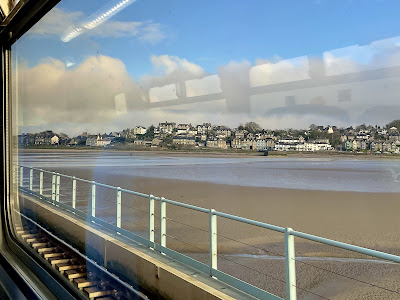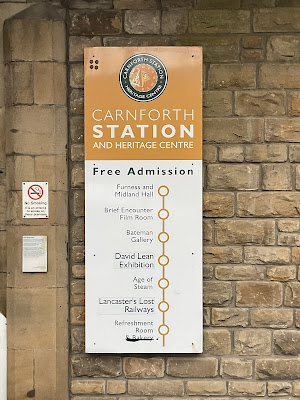CHARNEY HALL The Last Train
On the day that I decided to return to Barrow and the Cumbrian Archive Centre my car misbehaved. So not to be discouraged, I bought a return ticket from Carnforth, partly for convenience (the coast road can be slow occasionally due to the density of traffic) but also to rekindle the experience of that familiar line.
If I remember correctly in my day (1953-58) the end of term school train was a commissioned ‘special’ and it was pulled by a black steamy, steam engine. We boarded at Grange but goodness knows where it terminated - presumably where the last boy left the train - Leeds? York? All I remember is that I was told in no uncertain terms, not to forget to disembark at Hellifield where my father would be waiting for me in the car to take me home. Today’s version however is a two carriage diesel train resembling a caterpillar - reliable, comfortable, on time but boring!
Grange-over-Sands Station - Platform no.1 1958
I remember leaning out of the carriage door as the steam valve was opened to charge the cylinders, followed by that familiar release of enormous power which eased the train forward. If too much steam was released the wheels would spin on the locomotive. We had dropped the window on the door at the end of the corridor, I had my Kodak Brownie to hand, and there was just enough time to snap my last school photograph of the staff bidding the final farewell as the train slid past the end of the platform.
There were mixed feelings for the leavers. We had completed a 4/5 year term at Charney Hall - for some almost half their lives - an achievement in itself, but we were only a summer holiday away from an uncertain, unknown life at public school. It was like starting life all over again.
I emerged from Barrow library at 4pm into a beautiful sunny evening. There was time to take a circuitous stroll around the town centre, admiring the wide airy main streets and generous pavements and back to the station for the return journey.
The train line touches the coast at many points. When it does the magnificence of the Morecambe Bay is revealed, even more so on that fine evening. The immense area of flat sand and water opens up the sky and the light just floods in. The evening light bathed the dead stalks of last years crop of long grass turning it into a golden carpet which lined the edge of the railway embankment. In other parts the tide has scoured the spartina grass and sea washed turf creating small channels which drain the seawater back to the main estuary.
Ulverston, Dalton-in-Furness, Cark-in-Cartmel, Humphrey Head, Kent’s Bank, all familiar names, passed until the train reached Platform no.2 at Grange Station where history was about to repeat itself. Here the station buildings, platforms and promenade are squeezed up to against the foreshore which has metamorphosed over the years from a sticky, muddy, silty sand forming the channel of the River Kent which in those times touched the curved, concave concrete walls of the open-air swimming pool, to a grass plateau similar to that found across the estuary in Silverdale and Bolton-le-Sands.
On the school train, upon leaving Grange Station, we immediately looked out for the golf course, wedged between the train line, the estuary, where Maxwell Duncan was known to be a member, and Holme Island which was not strictly an island as it was connected to the mainland with a causeway. The owner of the large house hidden amongst the trees remains a mystery to this day.
The line then takes a gentle right hand, regular curve to align the track at right angles to the estuary in order for the Arnside viaduct to cross at the most convenient point - a true engineer’s solution.
Thereafter the train stops at Silverdale, the marshes of the RSPB Leighton Moss flash by first on the left hand side then on the right. At this point a feeling of urgency reminded me that I must gather my things together as the train would not dally at Carnforth.
Carnforth was once a train town with a state-of-the-art motive power depot eventually opened in December 1944. Now the remaining sidings, presently packed with a line of sad, retired diesel engines, are a reminder of the hive of industry that once existed with extensive engine sheds and sidings hosting steam shunters and freight wagons piled to the brim. On the main lines express trains came from London, Glasgow and Leeds. The curved brutalist Art Deco concrete and steel canopies are still there as a reminder of those heady days when steam had risen to be the fastest mode of transport throughout the country.
It is only recently that I have learnt that Carnforth Station is now famous for the filming of the classic 1945 film ‘Brief Encounter’ directed by David Lean and starring Celia Johnson and Trevor Howard - a question that Raymond Hirst should have included in his annual general knowledge test! ‘ Did we ever see this film on Sunday afternoons or was it deemed just too risqué?
‘Carnforth was chosen because of its distance from the German airfields and the subsequent relaxation of the blackout regulations so far north’. Hmmm
https://en.wikipedia.org/wiki/Grange-over-Sands_railway_station
https://en.wikipedia.org/wiki/Carnforth_railway_station
http://thebenthamline.co.uk/wp-content/uploads/2021/03/Carnforth-History-Panel.pdf
Note : Most colour photos were taken on my iPad running alongside a moving train!






















Comments